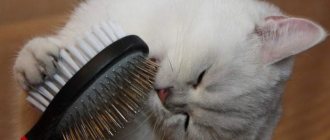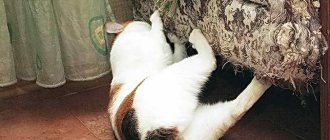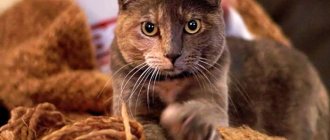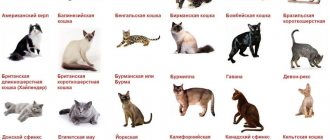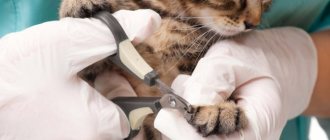Hunter cat
- Fact 1:
The best rat-catchers are females - Fact 2:
The droppings from rat-catching cats sell like hotcakes. After all, hunting instincts are inherited by children. - Fact 3:
It is quite acceptable not to give dinner before night exploits; a hungry animal is much more active in pursuing cunning prey - Fact 4:
It will be quite difficult for a fat cat to cope with the task, and why would he need it if he is full all the time?
The most ancient hunting instinct helps any pussy to cope with catching insects, birds, and small rodents. However, cats have a wary attitude towards rats and cats prefer not to get involved with them. Meanwhile, the “vile creatures” that people consider rats can really do a lot of harm: they destroy food supplies, bite children and carry deadly infections. The problem cannot be solved by simply bringing the first cat you come across into the house. To hunt arrogant rodents, you need a special type of cat - a rat catcher.
History of Pied Pipers
The domestication of cats occurred in Egypt approximately 9 thousand years BC. e. In those days, the grain harvested from the fields was eaten by mice and rats. People saw how cats hunted them and began to lure and tame the nimble hunters. Since then, these animals have taken their place next to people, ridding them of rodents. For such merits, cats were called sacred animals, protecting food supplies and saving people from hunger. Since ancient times, cats have been given special honors, and high fines were imposed for killing them. The cost of a clever rat-catcher cat was equal to the cost of an ox.
Agile rat-catching cats in the old days were worth as much as an ox
There is a legend that says that during the global flood, rodents appeared on Noah’s Ark, dangerous to the inhabitants. Then cats were born from the lions, destroying all the rodents and saving the animals on the ship from them.
Cats conscientiously performed their duties in peasant homes, in monasteries, and at the royal court. Peter I ordered the adoption of cats to protect barns from the invasion of mice and rats. By order of Elizabeth, his daughter, 30 rat-catcher cats were brought to the Winter Palace from Kazan, the city where the most dexterous rat-catchers were believed to live. During the reign of Catherine II, cats appeared in the Hermitage to protect works of art from rodents.
During the siege of Leningrad, cats saved residents and the city itself 2 times. When, in the first years of the siege, all the animals were eaten due to hunger, many rodents appeared in the city, and the Winter Palace was simply swarming with them. To combat dangerous rodents, 5 thousand smoky cats were brought from Yaroslavl to Leningrad in April 1943, then a train of Siberian cats arrived, and soon rodents disappeared from the city.
Cats still regularly serve in the Hermitage, protecting the country’s cultural heritage from rodents and forming an integral part of museum life; they are its unique symbol. Museum employees say that throwing cats out into the street is like throwing a painting by an outstanding artist from the 10th floor.
Cats in the Hermitage protect the country's cultural heritage from rodents
General features of rat catchers
The rat catcher is not a separate breed of cat, it is the valuable quality of the animal, the sharpness of its hunting instinct. According to felinologists (specialists in breeding cats), rat-catching cats can be identified by the following characteristics:
- muscular body, powerful jaws, strong legs;
- head shape - there is a relationship between the genes responsible for the instincts of hunters and the genes that determine the configuration of the skull of cats: rat-catching abilities are observed in animals with a triangular head (oriental type of cats);
- lush mustache and high ears with tassels at the ends: they allow animals to detect possible rustles, and this is very important for a successful hunt.
Ratcatcher cats usually have large ears that can detect the smallest noises.
Some rat hunters may be affectionate in nature, while others may be unsociable. There are animals that want to please their owner and often catch rats to show him their love. And there are cats that avoid people and do not welcome affection, but this is also quite normal.
How to identify a hunter cat
Not every cat will risk getting involved with a rat because of its impressive size. Therefore, the build of the future hunter must be appropriate: quite large, with a developed, muscular body and a powerful grip with strong jaws. Do not confuse a muscular animal with just a well-fed couch potato. This guy will never catch rats.
For reference:
The best rat-catchers are females.
Their rapid mercilessness aimed at malicious little ones is associated with parental instinct. The rat is an enemy that threatens the offspring and the mother will desperately defend it .
The litter from rat-catching cats sells like hot cakes. After all, hunting instincts are inherited by children, and mothers will personally teach their offspring the art of rat catching. If you want to get a good hunter, do not take the kitten away from its mother before it has learned all the tricks.
Breeds of rat-catching cats
There are certain breeds in the cat family, whose representatives are distinguished by excellent health, special dexterity and dexterity in catching rats.
Siberian cat
The cat was named Siberian due to its fluffy long hair. She is unpretentious, has a strong build, the weight of cats reaches 7 kg, cats weigh about 9 kg. She has strong paws and excellent grip. Due to the slightly longer hind legs compared to the front legs, the cat has the ability to run and jump quickly. Such animals are obstinate in nature, they have an excellent reaction, which is necessary when catching rats. They are independent and love freedom.
The Siberian cat has a strong build and excellent grip.
To maintain the desired shape, Siberian cats require regular walks in the fresh air.
Maine Coon
Cats of this breed are distinguished by mobility and strength. Maine Coons are hardy and able to live in regions with harsh climatic conditions. These large animals (males can weigh up to 15 kg) have the nature of a predator; they do not welcome human affection. Due to their size, they can easily deal with rats.
Maine Coons easily deal with rats
This breed of cat is distinguished by straight-set large ears, which have tassels at the ends. Maine Coons have long and thick fur. They have well-developed muscles, a wide chest, strong bones, and a thick and long tail. All this data allows Maine Coons to become a real threat to rodents.
Kurilian Bobtail
A feature of animals of this breed is a short tail, the length of which does not exceed 3–8 cm. But they have strong hind legs, which are longer than the forelimbs. And therefore the Kurilian bobtail runs well, jumps, and deftly strangles rats. Males of this breed weigh about 10 kg, females - 6 kg.
The Kurilian Bobtail is fearless and deftly strangles rats
Such cats are capable of completely destroying a mouse or rat hole. They are easy to train and can be trained. People keep them as companions; they get along easily with other animals. Bobtails have a fearless character.
European shorthair cat
Representatives of this breed destroyed rodents back in the days of Ancient Rome. European shorthair cats are called yard cats and are not considered purebred. However, they are popular in the world and are one of the best rat catchers. The predator's passion and agility help them successfully hunt rats and mice.
European shorthair cats are some of the best rat catchers.
Such cats are distinguished by individuality, independence, grace, and aristocratic appearance. They have a short coat, gray or silver marbled in color.
European cats get along well with people and are non-aggressive. They love to play, but do not completely obey their owner.
Cymric
Animals of this breed are similar to ordinary cats, but with a short tail. This structure, along with agility and tenacious claws, makes the Cymric a successful rat catcher.
Agility and tenacious claws make the Cymric a successful rat catcher.
It is good to keep these cats in private homes with open areas, as the animals require regular walks in the fresh air, freedom of movement, and physical activity.
British Shorthair
The hunting instinct and excellent natural inclinations make the British excellent rat catchers. Such cats are calm, friendly, and attractive in appearance. They love to please their owner by bringing him a caught rodent in their teeth in order to exchange it for rewards and something tasty.
Natural inclinations and hunting instinct make British Shorthairs excellent rodent catchers.
Females, weighing an average of 4 kg, try not to attack large rats, hunting only young ones or mice. Often this is enough to avoid a rodent infestation.
Russian blue
Russian blue cats are medium in size and light in weight, but this does not interfere with their hunting habits. Instant reaction and silent movement for a long time make these cats good rat catchers.
The Russian Blue cat has the ability to move silently and react instantly.
The ability of the Russian Blue to react to rodents is a true art: its speed of attack on the prey, accuracy and grace of movements are captivating. This is a thunderstorm of super rats, weighing about 500 g. The Russian Blue does not like partners of other cat breeds, but gets along well with rat catchers of its own breed. Opponent of tenderness from the owner.
Raising a rat-catcher kitten
A young animal should be accustomed to rat hunting from childhood. Owners don’t really rack their brains about how to do this and believe that hunger is the best way to motivate their pet to action. This is true, but only partially. It is quite acceptable not to give dinner before night exploits; a hungry animal pursues cunning prey much more actively. But you can’t completely deprive your cat of food. Such a “diet” will force the animal to eat garbage, beg for food from neighbors, and climb on tables. A weak ward will instinctively not get involved with a stronger opponent.
The diet should be regular, high in calories, but not fatty. A cat should be full of energy, muscle and excitement, not fat and laziness. Still, the best way to master the science of rat hunting is to learn the skills from your mother. Do not rush to tear the kitten away from her, otherwise the result may be completely opposite.
It will be quite difficult for a fat cat to cope with the task, and why would he need it if he is full all the time. At the same time, you should not take these words as a guide to action, urgently transferring the animal to a dietary diet, or even giving it a pestilence in order to stimulate its hunting instincts.
You need to remember that these abilities are either inherent from birth, or they don’t exist at all, so trying to re-educate your own pet using such a barbaric method certainly won’t work; rather, he will start rummaging around in garbage cans or begging for food in other places.
Features of care and maintenance
A real rat catcher can be raised from a small kitten. You just need to use some tips:
- To maintain the hunting instinct, the animal should be given food in small portions at least 5-6 times a day. To prevent the cat from becoming lazy, it should not be overfed. Food should not be in the bowl all the time, but the cat should not be left hungry either, since the rat hunter will need strength to attack the rodents.
- It is necessary to cultivate a hunting sense in the future rat catcher, praise and encourage him for any prey he catches: a bird, a mouse, a fly.
- It is difficult for a person to raise a kitten to be a rodent hunter, and therefore there is no need to separate it from its mother cat for up to 5 months so that during this time she can teach him the necessary skills.
- The pet must lead an active lifestyle; it requires not only toys in the form of balls, mice, bows, but also special play complexes.
The gaming complex will help your pet maintain an active lifestyle
- Rat catchers need to be vaccinated against rabies to boost their immunity, since rats are aggressive animals. When cats receive wounds from rodents, the damaged areas must be carefully treated and consulted with a veterinarian.
Otherwise, the care and maintenance of rat catchers is no different from the care of ordinary cats.
Ratcatcher cats for rent: where to find, cost
Buying a real rat catcher is quite difficult: you can be deceived for a lot of money. However, in some cities it is possible to rent a cat. You should know that ratcatcher cats are available for rent from breeders, many specialized nurseries, and animal and pet supply stores. After the rats are killed, the animal is returned.
For a cat, being in a new place with unfamiliar people can be stressful, so you cannot be sure that in such an environment he will catch rodents.
You can rent a ratcatcher cat
For this purpose, you can find a rat-catcher cat via the Internet, using message boards, for example, the site for finding part-time jobs YouDo, or specialized forums. There is no fixed price for such services; sometimes it is set depending on the cost of the cat itself. Typically, the price of such a service varies from 500 to 3 thousand rubles.
Forum participants generally have a negative attitude towards giving their animal to catch rats, since no one wants to create a stressful environment for the cat, and besides, this can be dangerous: the rats may already be poisoned.
Choosing a Pied Piper
The rat is a large rodent pest that not everyone can handle. The most important thing to look at when choosing a rat-catcher cat is its size.
The best option is an animal with large jaws and a powerful and strong body. But remember that a big cat is not necessarily an ideal rat-catcher, because its body must have outstanding dimensions not because of fat, but because of muscles.
Cats are considered the most ruthless rat killers. Felinologists believe that this directly concerns their maternal instinct: a cat considers a rat dangerous for its kittens even if there are no kittens in sight.
On the Internet you can find advertisements for the sale of kittens born to a rat-catcher cat.
Most likely, buying such a pet will not bring the desired effect, because these abilities are not inherited.
The mother cat herself must develop such a skill in her offspring, so the kitten cannot be taken away from its mother until it has mastered this art.

